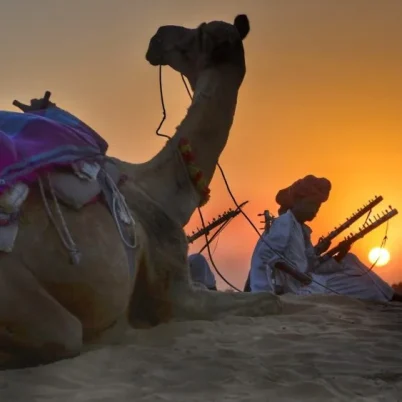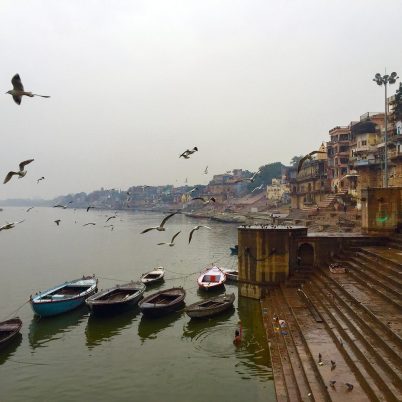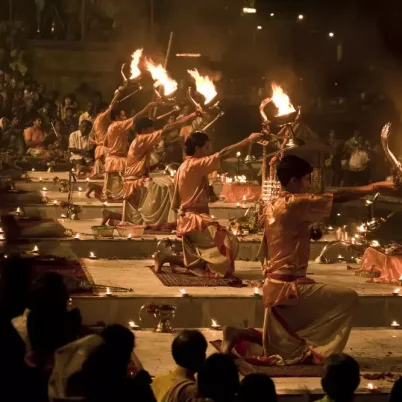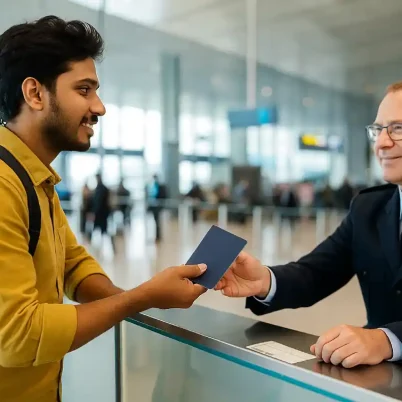
The Great Indian Wedding is fun, messy, chaotic, and grand, and if you are invited to one, you certainly cannot miss this experience! “Visiting Indian Weddings: A guide for foreigners” is a blog that is absolutely necessary, especially if you are attending an Indian wedding for the first time. Read on to find out all you need to know before attending this unique experience!
Indian Weddings: An Overview
Indian weddings are an experience. There are many religions and castes in India, so each Indian wedding is different from the other. However, one thing is constant – the importance of rituals. Most Indian weddings have many religious rituals, and each one has a deep meaning. Whether you attend a Hindu, Muslim, or Sikh wedding, there is a good chance that you will be bewildered with all the traditions that are such an integral part of every Indian wedding.
While Indian weddings stretch for 3 to 5 days with 4 to 5 main functions, some of the functions are only for very close friends and family. So check your invitation to see which events you are invited to, and plan accordingly!
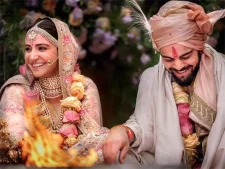 Indian weddings have many rituals
Indian weddings have many rituals
Events
Events and rituals in Indian weddings differ from one wedding to another, but the majority of weddings now have at least 4 to 5 main functions, and last for at least 3 days. The tag of “The Big Fat Indian Wedding” is certainly not exaggerated!
Roka/Engagement Ceremony
The Roka Ceremony or the Engagement Ceremony usually takes place a few months before the wedding. This ceremony is an official wedding announcement of the couple to their friends, families, and other guests. This ceremony is mostly an intimate affair with a few people from both the groom’s and bride’s sides.
Mehndi Ceremony
Henna plays a big role in Indian weddings. Henna, or Mehendi, is applied to the bride’s hands and feet with beautiful designs during Mehndi Ceremony. This event usually takes place 2 to 3 days before the wedding day. The bride often needs to sit for hours to finish up, but friends and family members keep her entertained with music and dancing. Many female guests also get Mehendi applied to at least one hand during the ceremony.
Sangeet Ceremony
Traditionally, Sangeet was an event limited to the northern parts of India, but today, the Sangeet Ceremony has become a big function in most of India, gaining its own individual spot in the line-up of wedding events.
This is probably the most fun event of a wedding. Usually held before the big day, the ceremony has special themes and dance performances prepared by the bride, groom, and their families and friends. There is a lot of fun, laughter, food, and music during this event, so that everyone can momentarily forget the stress of the events and enjoy the present.
Haldi Ceremony
The Haldi Ceremony is held before the wedding ceremony, or after the mehendi ceremony. On this day, Haldi, or turmeric, is applied to the bride and groom’s body by their family and friends. Haldi is a natural skincare product in India – it purifies the skin and makes it glow, just what is needed before your special day. The yellow color of turmeric is also considered auspicious.
Once the bride and groom are smeared with haldi by everyone, the guests apply it on each other’s faces as well!
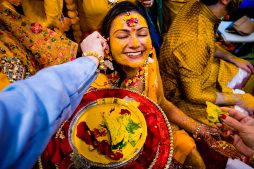
Wedding Ceremony
This is the actual wedding ceremony. Every caste, region, and religion has its own rituals. In Hindu wedding ceremonies, the groom and bride enter separately with pomp and splendour. They exchange flower garlands, or varmala, and take their vows in front of the holy fire. They then take pheres (rounds) around the fire. The couple is declared to be married with all their loved ones as witnesses. The couple then seek the blessings of the priest and all the elders in the family. It is a fun and joyful event.
Reception
Reception is a post-wedding ceremony that basically introduces the bride and the groom to each other’s families and friends. There is a grand feast during this event and the bride and groom meet everyone and exchange niceties.
While these are the main events of any wedding in India, by no means are these the only functions. There are many more mini-functions and rituals that surround this elaborate concept of Indian weddings, such as Ganesh Pujan, Baaraat, Vidaai, and Grihapravesh.
What to Wear to an Indian Wedding?
The Indian dress code for weddings is very different from that for a Western wedding. While Western weddings are subtle and minimal, you will find Indian weddings an epitome of maximalism.
There are at least three days worth of events in Indian weddings, so you might need different outfits for different events. Weddings these days usually have a pre-decided dress code that they send along with the invitation. However, if you don’t find any, you can always ask someone from the bridal party for suggestions, and they will be more than happy to help you out.
For women
No matter what you wear, you will never upstage an Indian bride. In India, it is completely okay to wear rich, heavy clothes and jewelry, bright colors, and makeup. In fact, it is even encouraged, as weddings are one of the few occasions where everyone gets to show off their jewelry and outfit collection, unless the wedding is intentionally low-key.
Try to avoid wearing the color red on the wedding day, as brides typically wear red. But with more and more brides choosing to wear pastels and other colors for their ceremony, there is no hard and fast rule about colors.
However, do avoid wearing pure white or black during the main wedding function. White is associated with mourning, while black is considered inauspicious. These colors are okay for the other events, but not the actual wedding ceremony.
If no dress code is mentioned, you can wear breezy, semi-traditional fits in shades of green for the Mehendi ceremony. If you are planning on applying henna on your hands, wear something that won’t get in the way.
For Haldi, you can wear yellow, orange, or white if you don’t know what to wear. This event can get fun and messy as everyone starts applying haldi to everyone, so wear light, no-fuss clothes for this event – there is a good chance your outfit will get stained yellow!
You can go glam for the Sangeet ceremony – try wearing some Indo-fusion outfits that are comfortable enough to dance the night away.
For the religious wedding ceremony and the reception, wear something traditional in bright tones, like a saree, lehenga, or a salwar-kameez or anarkali suit. Keep in mind that sarees are tricky, so be very careful if it is your first time wearing one, or opt for pre-draped sarees.
You can accessorize with jewelry like earrings, necklaces, bracelets, bangles, or maang-tikka. A timeless watch and a small purse or bag can also be a nice addition.
Read more: What to wear in India?
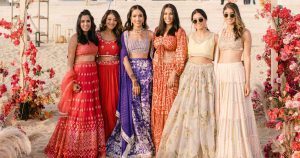
For men
For men, the dress code is quite simple, even if it isn’t mentioned. You can wear traditional Indian wedding clothes for most functions. For the Mehendi and Haldi ceremonies, you can wear a simple but vibrant kurta pajama set, or even a shirt with trousers.
For the main event, you can wear a nice sherwani or bandhgala suit. Even a suit and blazer works well for the Sangeet and Reception.
Gifting at Indian Weddings
Giving gifts to the newlyweds is a common tradition at Indian weddings, even if the invitation mentions not to bring any. The concept of wedding registry is not common in Indian weddings, so the most safe gift to give the couple is money, put in a decorative envelope.
The amount of money to put in the envelope honestly depends on how close you are to the couple and how much you can afford. You can also put in the equivalent of how much a physical gift would cost.
Some other good gift ideas are jewelry, home decor, or silver items.

Some things to keep in mind
- Indian weddings often take place at odd hours. Many North Indian weddings take place after midnight, while a lot of South Indian weddings start even before sunrise! Know the time of the wedding beforehand, so that you can plan your sleep accordingly.
- It is okay to take pictures during the wedding ceremony, but make sure you are not blocking anyone’s view, or getting in the way of the photographers. Also, avoid using flash while taking your shot.
- Indian weddings usually have a lot more guests than any Western wedding, so may be overwhelmed with the chaos. But at weddings, more is always merrier, and you will soon find the crowd quite fun.
- Food is probably one of the most important parts of Indian weddings. Indian weddings usually have buffets for the wedding meals, and most meals at weddings are pure vegetarian. Don’t hesitate to try all the different food items that you see!
- You may have to book a hotel or stay near the wedding venue in advance, since much of it will be booked solid by the wedding party.
So, does this information sound helpful? Let us know! At India Someday, we create personalized itineraries for a trip to India based on your likes and requirements. If you are planning a trip to India, contact us and we can help you travel India your way!
Frequently Asked Questions
It is definitely worth attending an Indian wedding! The beautiful traditions and rituals that span for over three days at an Indian wedding are nothing short of a spectacle. You might get overwhelmed with the intensity of it, but this is an experience that you should not miss if you get the chance!
The Indian wedding industry is one of the most money-making industries in the country. Indian weddings are an expensive affair for a number of reasons – the large number of guests, elaborate rituals that go on for days, and the show-off of wealth and status.
Indian weddings take place over 3 to 5 days. Each day has 1 or 2 events, with every event carrying deep meaning.
helping you travel your way
Everything you need to know about India is here We have tried writing about everything you may need help with for your trip to India, If you need help in planning a trip to India Get in touch with us to to plan your trip of a life time.


